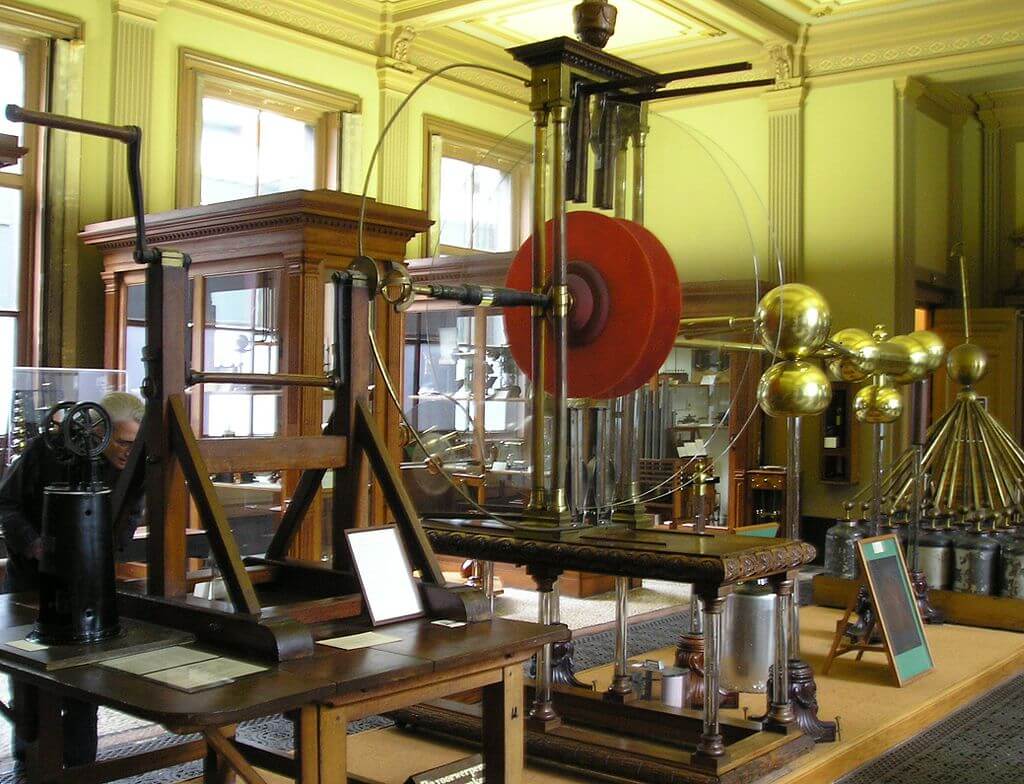What is the historical background of electrostatic generators? Information about the history of invention of electrostatic generator.
ELECTROSTATIC GENERATOR, a device that uses mechanical work to concentrate positive or negative electric charge at a high voltage. The generator separates negative charge (electrons) from matter, leaving it positively charged. The machine also stores the resulting negative and positive charges so that they cannot recombine. The three common processes for concentrating positive or negative charges are (1) frictional charging, in which electrons leave one surface and cling to another surface; (2) induction, in which charge of one polarity on an object attracts charge of the opposite polarity in a nearby conductor; and (3) corona discharge, in which electrons pass through a gas in one direction, and positive gas ions pass through the gas in the other direction.

Martinus van Marum’s Electrostatic generator at Teylers Museum (Source: wikipedia.org)
HISTORICAL BACKGROUND
When common materials such as amber and fur are rubbed together, they become electrically charged objects that produce readily visible effects—namely, the attraction or repulsion of nearby light objects such as hair. The effects of static electrification were first observed and recorded in 600 b. c. by the Greek philosopher Thales. Despite the long history and the apparent simplicity of static electricity, useful experimentation did not begin until 1600. In that year William Gilbert published his great book De Magnete, in which he devoted one chapter to the amber effect and emphasized the difference between the electrification of amber and the magnetism of lodestone.
Frictional Machines
The earliest frictional machine on record was made by Otto von Guericke about 1660. He mounted a large ball of sulfur on an axle and rotated the ball by means of a crank. When rubbed by hand, the rotating surface of the ball rapidly developed a strong electric charge. In England in 1706, Francis Hauksbee built an electrostatic generator by spinning glass spheres or cylinders on an axle and rubbing them by hand. In 1744, Johann H. Winckler, a professor of physics at Leipzig, used a leather cushion to rub against the spinning glass sphere of a Hauksbee-type generator. By 1745, when E. Georg von Kleist and Pieter von Musschenbroeck developed the Leyden jar to store electric charge, all the essential parts of a frictional electrostatic generator were available.
Jesse Ramsden, an English instrument maker, in 1768 constructed a friction machine that was a forerunner of many later ones. It had a large glass disk that was rubbed by two leather friction pads when the disk was driven by a hand crank. Portions of the surface rubbed by the pads were covered with silk. Sharp points close to the glass neutralized the positive charge developed by friction on the surface of the glass when the disk was turned. Neutralization occurred by a corona discharge in which electrons sprayed onto the glass from the points, leaving the electrode holding them charged positively. In 1787 the English physicist Edward Nairne used a similar device that had a glass cylinder instead of a disk. He was able to supply positive of negative charge by connecting the external electrode to the discharge points or to the leather cushion.
Although men have produced static electricity by friction for more than 2,000 years, the process by which electrons leave one surface and cling to another has not yet been fully explained.
Induction Machines
In an induction, or influence, machine, one charged object induces an opposite charge in a second object. While held near each other, the first charged object repels charges of like polarity in the second object. When the second object is connected to ground, the repelled charges flow to ground. If the ground connection is broken and the first object is removed from the vicinity of the second object, the second object retains a charge opposite in polarity to that of the first object.
Alessandro Volta invented the electrophorus in 1775 and used this type of electrostatic generator to demonstrate the induction effect. Volta’s ideas ushered in a variety of new induction machines. Abraham Bennet, an English clergyman, experimented with a “doubler” for multiplying electric charges about 1786. It consisted of three conducting disks and insulating plates with which an initial charge on one disk could be multiplied by a factor close to two every time a cycle of induction and charge transfer was carried out in a certain sequence. Another ingenious induction machine, also called a doubler, had rotating conducting plates driven by a hand crank. This machine was described by the English physicist William Nicholson in 1788.
After Nicholson, various induction machines were introduced. Giuseppe Belli, an Italian professor of physics, built a doubler in 1831. Cromwell F. Varley, an English electrical engineer, built a forerunner of many later induction machines in 1860. Other notable induction machines were built independently by the German physicists August J. I. Toepler and Wilhelm T. B. Holtz in 1865.
Kelvin Water Dropper.
An ingenious electrostatic generator called a water dropper was invented and demonstrated by Lord Kelvin (Sir William Thomson) in 1867. In this machine, water droplets from’ each of two nozzles were charged by induction by a surrounding metal shield. Droplets entering shield A were charged positively, while those entering shield B were charged negatively. The more strongly the shields A and B were charged, the more strongly charged were the droplets. Each of the droplets retained its charge as it separated from the nozzle and fell into a collecting tube.
In turn, the droplets charged the shields more highly via the collecting tubes, and thereby increased the charge on following droplets from the nozzles. Thus the machine multiplied any charges that were originally on the shields.
In practice, the machine was subject to unwanted electrical discharges through a droplet spray, and this defect prevented the attainment of very high voltages.
mavi